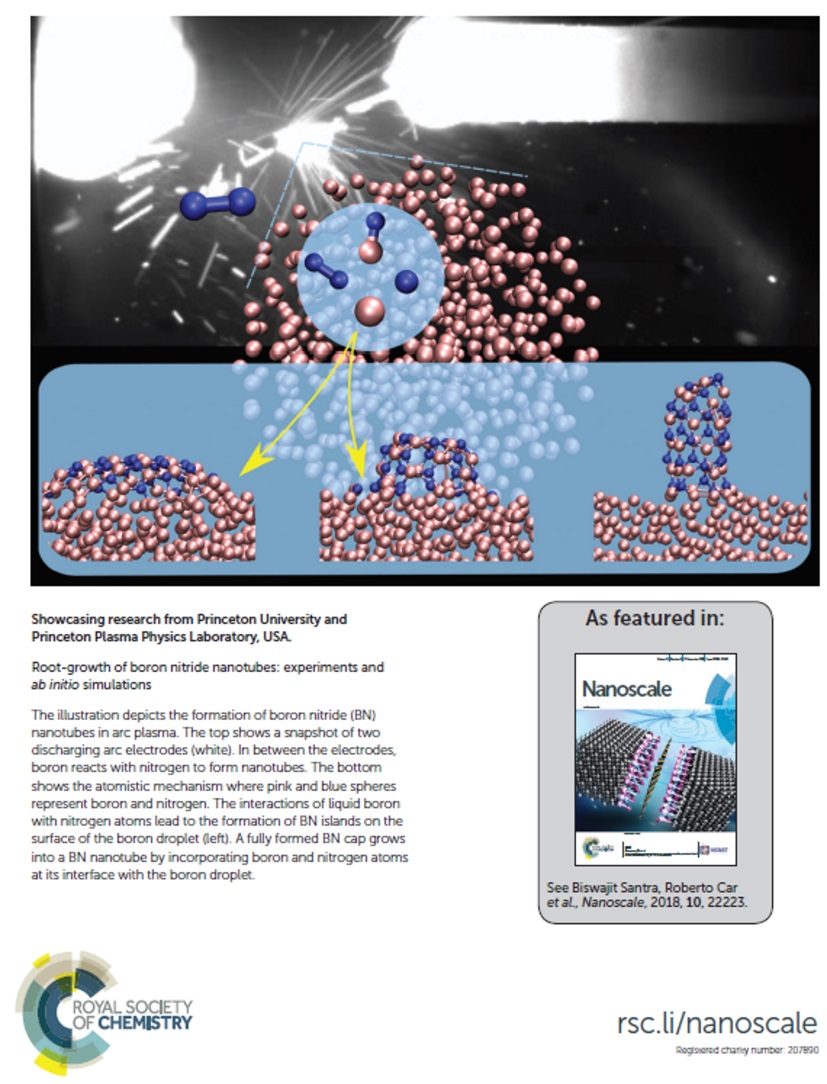Media
Nanolab in the News
-
PPPL research featured at Nanoscale
December 19, 2018
Source: Nanoscale
Big steps toward control of production of tiny building blocks
Nanoparticles such as carbon nanotubes are used in everything from microchips to sporting goods to pharmaceutical products. But large-scale production of high-quality particles faces challenges ranging from improving the selectivity of the synthesis that creates them and the quality of the synthesized material to the development of economical and reliable synthesis processes. However, this situation could change as a result of research at the U.S. Department of Energy’s (DOE) Princeton Plasma Physics Laboratory (PPPL), where scientists have developed the diagnostic tools that are being used to advance an improved and integrated understanding of plasma-based synthesis — a widely used but poorly understood tool for creating nanostructures.... read more at pppl.gov
March 6, 2018
Source: pppl.govThe Princeton University ‘Art of Science’ exhibition explores the interplay between science and art
Entries are chosen for their aesthetic excellence, their scientific or technical interest, and for their universal appeal that crosses cultures, languages and age groups. The 2017 selections, currently on view in the Friend Center atrium, drew from more than 170 submissions from a wide range of disciplines from astrophysical sciences to history, and includes images and videos by undergraduates, graduate students, faculty, alumni and staff.
The exhibit is free and open to public during Friend Center hours, weekdays 9 a.m. to 5 p.m... read more at princeton.edu
March 5, 2018
Source: princeton.eduSimulation demonstrates how exposure to plasma makes carbon nanotubes grow
At the U.S. Department of Energy’s (DOE) Princeton Plasma Physics Laboratory (PPPL), research performed with collaborators from Princeton University and the Institute for Advanced Computational Science at the State University of New York at Stony Brook has shown how plasma causes exceptionally strong, microscopic structures known as carbon nanotubes to grow. Such tubes, measured in billionths of a meter, are found in everything from electrodes to dental implants and have many advantageous properties. In principle, they have a tensile strength, or resistance to breaking when stretched, 100 times greater than that of a same-sized length of steel wire... read more at pppl.gov
August 11, 2017
Source: pppl.govAmerican scientist about Laboratory for Plasma Nanosynthesis
Too small to be seen by the human eye, nanoparticles are already transforming many scientific fields, from electrical engineering to materials science. Now scientists are working to optimize production.... read more at americanscientist.org
March, 2017
Source: americanscientist.orgPPPL scientist uncovers physics behind plasma-etching process
Physicist Igor Kaganovich at the Department of Energy's (DOE) Princeton Plasma Physics Laboratory (PPPL) and collaborators have uncovered some of the physics that make possible the etching of silicon computer chips, which power cell phones, computers, and a huge range of electronic devices. Specifically, the team found how electrically charged gas known as plasma makes the etching process more effective than it would otherwise be... read more at phys.org
January 27, 2017
Source: www.phys.orgRoberto Car elected as a member of the National Academy of Sciences
Roberto Car, the Ralph W. *31 Dornte Professor in Chemistry and the Princeton Institute for the Science and Technology of Materials, has been elected as a member of the National Academy of Sciences for his distinguished achievements in scientific research.... read more at chemistry.princeton.edu
May 3, 2016
Source: chemistry.princeton.eduRoberto Car received the American Chemical Society (ACS) Award in Theoretical Chemistry
Roberto Car, the Ralph W. *31 Dornte Professor in Chemistry and the Princeton Institute for the Science and Technology of Materials, has been elected as a member of the National Academy of Sciences for his distinguished achievements in scientific research.... read more at acs.org
January 4, 2016
Source: acs.orgPPPL receives $4.3 million to increase understanding of the role that plasma plays in synthesizing nanoparticles
The U.S. Department of Energy’s (DOE) Princeton Plasma Physics Laboratory (PPPL) has received some $4.3 million of DOE Office of Science funding, over three years, to develop an increased understanding of the role of plasma in the synthesis of nanoparticles.... read more at pppl.gov
June 9, 2014
Source: pppl.govNanotechnology at PPPL
Nanomaterials, which are measured in billionths of a meter, are prized for their use in everything from golf clubs and swimwear to microchips, paints and pharmaceutical products, thanks to their singular properties. These include exceptional strength and flexibility and high electrical conductivity. Carbon nanotubes, for example, are tens of thousands of times thinner than a human hair, yet are stronger than steel on an ounce-per-ounce basis.
PPPL researchers have launched a nanotechnology laboratory that they envision as a step toward research capabilities that could serve as a resource for institutions and industries around the world..... read more at pppl.gov
Source: pppl.govNano meets plasma at PPPL
Scientists at DOE's Princeton Plasma Physics Laboratory (PPPL) have launched a new effort to apply expertise in plasma to study and optimize the use of the hot, electrically charged gas as a tool for producing nanoparticles. This research aims to advance the understanding of plasma-based synthesis processes, and could lead to new methods for creating high-quality nanomaterials at relatively low cost..... read more at DOE Pulse
October 22, 2012
Source: DOE pulse


